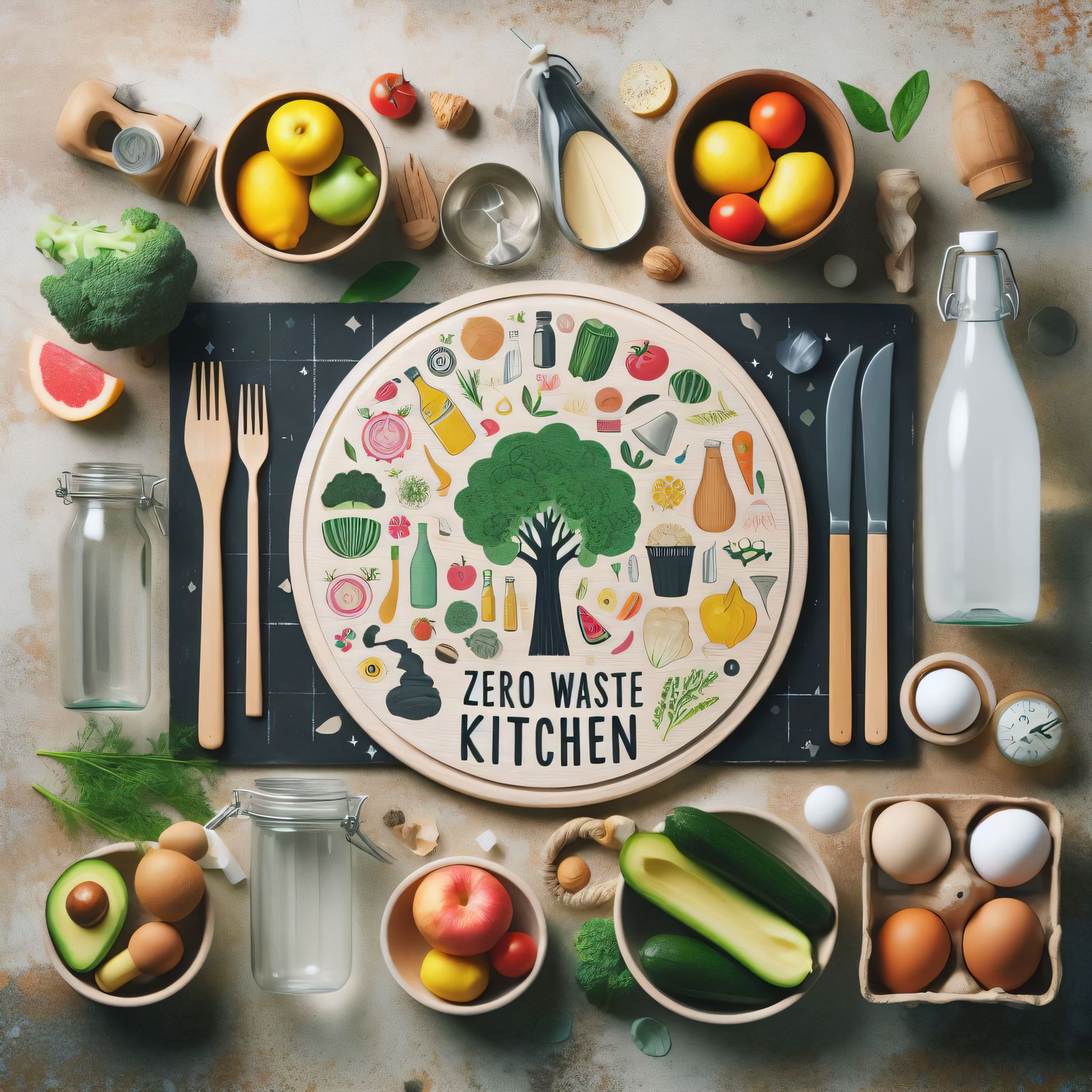Embarking on a zero waste kitchen journey might seem daunting, but our guide is here to show you it’s an exciting and achievable goal. This comprehensive guide, filled with practical tips and easy-to-follow advice, will help you transform your kitchen into a sustainable powerhouse. Discover how simple changes can lead to significant impacts, reducing waste, conserving resources, and contributing to a healthier planet. Are you ready to embrace a more mindful and fulfilling lifestyle through a sustainable kitchen? Let’s dive in.
The Journey to a Sustainable Kitchen
Creating a sustainable kitchen is a continuous journey of small changes that collectively make a big difference. Don’t try to overhaul everything at once – start with a few key areas and build momentum over time. The following practical tips will help you transform your kitchen into a model of sustainability.
Ban Single-Use Plastics
Eliminating single-use plastics is one of the most direct ways to create a greener kitchen. Replace plastic wrap with reusable alternatives like Beeswrap reusable cloth wraps. Switch from Ziploc bags to reusable silicone bags from Stasher or silicone stretch lids from Uniq. Ditch disposable straws and opt for glass or steel straws – options like FinalStraw collapse for easy portability. When buying groceries and takeout, say no to plastic bags and utensils. Keep reusable shopping bags like BagPodz and utensil sets like To-Go Ware in your car so you’re always prepared.
Conserve Water
The kitchen faucet can be a major source of wasted water. Install low-flow faucet aerators like Neoperl to conserve water without sacrificing pressure. When washing dishes by hand, don’t leave the water running. Fill the sink or a basin and then turn off the tap. You can find space-saving sink basins like Joseph Joseph Wash & Drain that fit inside your sink. Water plants with leftover water from boiling pasta or vegetables rather than pouring it down the drain.
Preserve Food to Prevent Waste
Food waste is a substantial contributor to landfills, emitting greenhouse gases as it decomposes. Thoughtful meal planning and smart storage are key to reducing waste. Use apps like Fridge Hero to track items and get alerts when food is close to expiring. Invest in storage containers like the Rubbermaid FreshWorks Produce Saver that regulates airflow and moisture to make produce last longer. Learn techniques like water blanching and freeze drying with Harvest Right home food dryers to preserve abundant garden vegetables at their peak. The book Food Waste: Tips and Recipes for Every Kitchen shows creative ways to use commonly wasted foods like carrot tops and watermelon rinds.
Choose Energy Efficient Appliances
Major kitchen appliances account for over 15% of household energy use. When purchasing new models, look for the Energy Star Most Efficient certification to maximize savings. Brands like Bosch, LG, and Samsung offer ENERGY STAR dishwashers that use less water and electricity. Opt for an induction cooktop like the Frigidaire Gallery Series; it heats faster and is over 20% more efficient than electric. Pair your induction cooktop with pots and pans designed for induction like Circulon Momentum or Cuisinel Castelle for optimum efficiency.
Shop Local and Organic When Possible
The distances our food travels has major climate impacts. Support local farmers by shopping at farmer’s markets and joining Community Supported Agriculture (CSA) programs that deliver seasonal produce boxes from nearby farms. Services like Local Harvest make it easy to find CSAs and family farms in your area. When local and organic options are not accessible or affordable, brands like Pristine Planet offer conventionally-grown produce at budget-friendly prices – their packaging is plastic-free and climate neutral certified.
Minimize Meat Consumption
Animal agriculture generates nearly 15% of global greenhouse gas emissions. Reducing meat intake – especially resource-intensive beef – is one of the most effective ways an individual can combat climate change. Designating one or two days per week as “plant-based days” is an easy way to start. The Well Your World plant-based meal plans offer simple recipes to reduce meat without sacrificing flavor.
Creative Ways to Reduce Kitchen Waste
In addition to preserving and properly storing food, reusing and repurposing kitchen scraps fosters a zero-waste lifestyle. Start composting using bins tailored for kitchen spaces like the Chef’n EcoCrock Counter Compost Bin. Incorporate food waste like carrot tops, onion bottoms, and herb stems directly into dishes instead of throwing them away – scrape them into a bag in your freezer until ready to use for vegetable broths, pestos, or soups. Reuse glass jars from pantry staples to store leftovers or dry goods. Upcycle old kitchen items: turn vintage silverware into windchimes or mobiles, salvage wood from an outdated spice rack to make cutting boards or wall art.
The Power of Natural Cleaning Solutions
Conventional cleaning products often contain harsh chemicals that get washed down drains, contaminating waterways. Create a non-toxic cleaning arsenal with versatile staples like distilled white vinegar, baking soda, castile soap, lemon juice, and essential oils. Use half a lemon drizzled with baking soda as a natural scrubber. Mix white vinegar with water and essential oils in a glass spray bottle to make an all-purpose cleaner and degreaser for just pennies per bottle. Soak pots and pans with burnt on food residue in hot water mixed with a paste of baking soda and castile soap – food rinses right off after soaking. Unwrap Life provides zero-waste natural cleaning concentrate tablets to simplify sustainable cleaning.
Additional Tips for a Greener Kitchen
Here are some bonus tips to amplify your sustainability efforts:
- Kitchen lighting accounts for 5-10% of household electricity. Use LED bulbs and maximize natural light with fixtures near windows to reduce energy use. Choose solar-powered LED touch lights like OStar Lighting to illuminate dark corners and cabinets without wiring.
- Help pollinators by growing indoor herb gardens with self-watering beds like Click & Grow Smart Gardens. Bonus – you’ll always have fresh herbs on hand.
- Look for natural, plastic-free alternative swaps for everyday items: trade paper towels for reusable bamboo towels from Crown Royal; use Swedish Dish Cloths instead of sponges; try produce bags made from recycled cotton like the BagPodz Mesh Produce Bags.
- When remodeling or replacing kitchen items, choose sustainable materials like bamboo, reclaimed wood, recycled glass tiles, natural stone, and recycled metal. Companies like Plyboo and Bedrock Industries offer beautiful reclaimed wood countertops. Use food-safe finishes like Livos plant-based finishes.
- Install high-efficiency particulate air (HEPA) filters in range hoods to purify cooking fumes and improve indoor air quality. Brands like Broan offer ductless hoods with HEPA filters built in.
The Legacy of a Sustainable Kitchen
Adopting sustainable kitchen practices is a voyage filled with mindful choices and positive impacts. By embracing reusable products, preventing food waste, conserving water and energy, making eco-conscious food choices, reducing waste through reuse and repurposing, and using natural cleaning solutions, we nurture personal and planetary health. Creating a model of sustainability in our kitchens allows us to pay it forward, inspiring others to follow suit. Small changes collectively transform communities and build momentum towards a circular economy founded on environmental stewardship. Let’s all strive to be sustainably-minded cooks, innovating and illuminating the path to a greener future.



